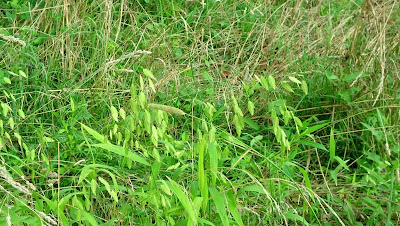The lost art of medicinal plants was highlighted at Bucktoe Creek Preserve this weekend. As part II of TLC's Wild Foraging Series, April Coburn, of
Nettlejuice Herbals, led a group of 12 into the diverse world of Bucktoe's medicinal flora. Thirty-two species are known to reside at Bucktoe- our group only managed to see around eighteen. April discussed identification tips, the correct parts of the plant to harvest and time of year, along with procedures to concoct at-home remedies. Her personal medicinal remedies were available for purchase at the event, but you can also visit
www.nettlejuice.blogspot.com for more information on her products.
Out of the numerous plants we discussed, here are a list of plants that I would like to share.
1. Plantain, Plantago major: Grows in very disturbed areas - easy to find in your backyard, or any common area where grass is mowed. Very effective way to draw out venom from a sting. Victim can briefly chew up the leaf and place it over the sting, rubbing in the leaf juice.

- Red Clover
2. Red Clover, Trifolium praetense: Known as an allterative, meaning it is all around good for your body. Continued use of this plant in teas or diet can remove toxins in the body, and help with several types of lung issues.
3. Monarda, Monarda fistulosa: Also known as Sweet Leaf, this plant has askew, purple flowers with thin petals and a square shaped stem. As a member of the mint family, Monarda is very effective at helping to reduce fever. A few participants had positive experiences using this plant for medicinal purposes.
4. Walnut Trees, Juglans nirgra: The hole of the nut is used as an anti-parastic, and is used to help fight Chrones disease and IBS. One

- Monarda
participant had even read information on using these in place of heartworm medication for dogs.
5. Jewelweed, Impatiens capensis: Often found in wetland areas, jewelweed is a strong preventative and cure for poison ivy. Used as a preventative by using the leaves in a tea form (1/4 cup suggested), and as a cure by rubbing the juice from the leaves onto the infected area.
As always, please be sure to positively identify any plants before using for medicinal purposes. Poisonous plants can often mimmic plants that are used for medicinal or edible purposes.
April also provide a list of ethics and guidelines for harvesting medicinal plants from the Rocky Mountain Herbalist Coalition:
1. Never gather endangered or threatened plants.
2. Positively ID before harvesting.
3. Ask permission, give thanks, acknowledge connection with all life, share appreciation.
4. Leave mature, seed producing plants, grandparent plants, within the stand and at the top of the hill to seed downslope.
5. If unsure, harvest no more than 10% of native whole plant and root. Gather only from abundant stands. Harvest conservatively.
Other than the numerous facts and helpful information gained during the hike, there was another take home message I really enjoyed: Sometimes, less is more. In our world today we sometimes believe more is better. Taking more medicine will relieve your headache faster, or using several types of ointments will make your skin glow again. When it comes to using plants for medicinal purposes, April stated that often times, taking less can be more effective.
 The other day, I received a text from one of our volunteers. There was a picture attached, and it said--
The other day, I received a text from one of our volunteers. There was a picture attached, and it said--.JPG)
.JPG)


















